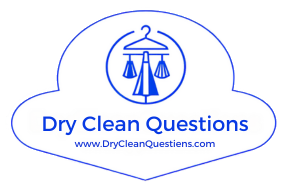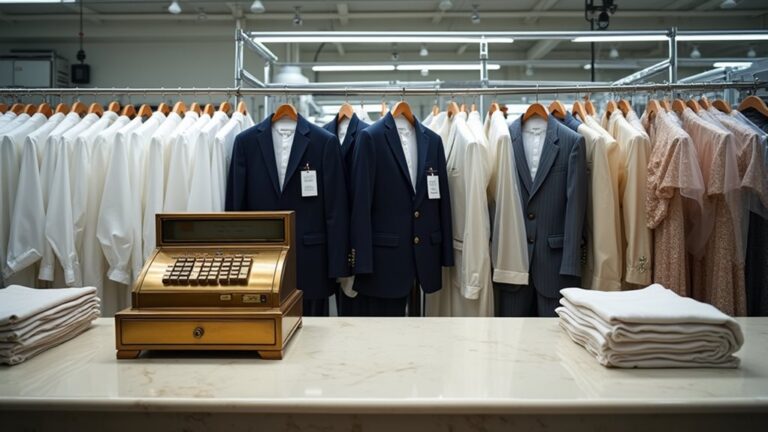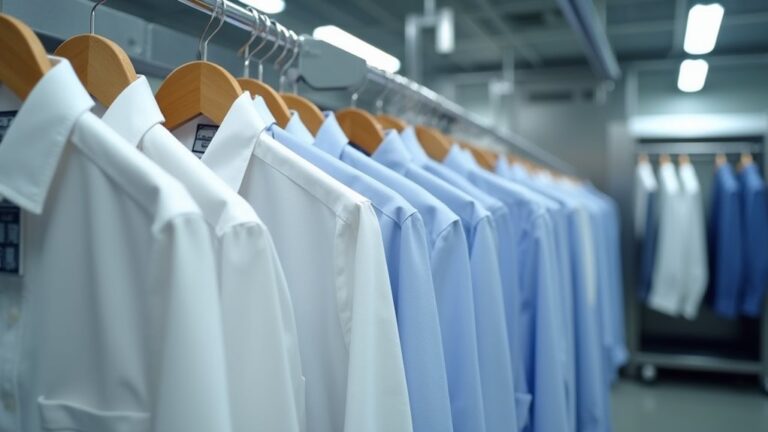Your dry cleaning business can realistically earn between $150,000 to $300,000 annually, though I’ve seen urban locations pull in $120,000 yearly while small-town shops settle around $24,000. You’ll typically pocket 5-8% profit margins after covering that hefty $80,000-$150,000 equipment investment and monthly expenses. Individual customers spend $20-50 per visit, and honestly, those business contracts for uniform cleaning become your bread and butter. Smart pricing and premium services can greatly boost these baseline numbers.
Revenue Streams and Pricing Structure for Dry Cleaning Services
Success in the dry cleaning business hinges on understanding your pricing sweet spot, because charging too little means you’re practically giving away your expertise, while pricing too high sends customers running to your competitors faster than you can say “starch.”
When I first started researching this industry, I was shocked to discover the pricing range spans from a modest $3 for a basic shirt to $30 for complex items like wedding dresses or heavy comforters. Honestly, that wide gap initially seemed arbitrary until I realized it reflects the skill, time, and specialized equipment required for each garment.
Your revenue streams extend beyond basic cleaning through additional services like stain removal and pressing, which can boost customer expenditure while improving profit margins and average monthly revenue against operational costs. Smart operators also capitalize on premium services like alterations and specialty cleaning, which command higher prices and contribute to building customer loyalty while enhancing overall profitability.
Customer Segmentation and Average Spending Patterns

You’ll discover that your customer base naturally splits into two distinct groups – individual customers who bring in their work clothes and special occasion outfits, and business clients like restaurants, hotels, and corporate offices that need regular uniform cleaning services.
When you break down the numbers, most individual customers spend between $20 to $50 per visit and show up anywhere from once to four times monthly, which honestly surprised me when I first saw how consistent people can be with their dry cleaning habits 😊.
Understanding the pricing factors that influence what customers pay – like garment type, fabric complexity, and special treatments – helps you optimize your service offerings and potentially increase the average ticket size per visit.
The real magic happens when you focus on building loyalty with both segments, because those repeat customers who trust you with their favorite suit or wedding dress become the backbone of your steady monthly revenue stream.
Individual Vs Business Clients
When you’re building a dry cleaning business, understanding the stark differences between individual clients and business clients becomes crucial for your financial success, as these two customer segments operate with completely different spending patterns and service expectations.
Individual clients typically visit 1-4 times monthly, spending $20-$50 per visit, which translates to an average annual contribution of $1,000-$1,200.
Business clients, however, often secure contracts for uniforms and work attire, generating markedly higher returns through consistent volume.
Smart customer segmentation allows you to diversify revenue streams effectively – individual clients provide steady baseline income, while business accounts offer the potential to stabilize income through predictable contracts.
Understanding these distinct service needs helps you tailor pricing strategies and allocate resources efficiently.
Individual customers seeking suit cleaning services typically fall within the $15-$25 price range per garment, though premium fabric care can command higher rates depending on material complexity and geographic market conditions.
Average Visit Spending
While researching dry cleaning businesses over the years, I’ve discovered that understanding your customers’ spending habits feels a bit like solving a puzzle – each piece reveals something crucial about your revenue potential.
When you examine average price patterns, you’ll notice customers typically spend $20 to $50 per visit, though this varies dramatically based on services utilized.
Your customer spending analysis should consider visit frequency, since individuals usually come 1-4 times monthly, creating annual expenditure ranging from $240 to $2,400.
Here’s what surprised me most: dry cleaning businesses often underestimate their revenue generation potential, with average customers contributing $1,000-$1,200 yearly.
That’s noteworthy recurring income! 📊 Focus on tracking these patterns, and you’ll reveal valuable insights about your business’s financial trajectory.
Understanding geographic location becomes critical when analyzing revenue potential, as urban areas typically command 20-40% higher prices than suburban or rural markets.
Frequency and Loyalty
Three distinct customer types emerge when I analyze dry cleaning loyalty patterns, and honestly, recognizing these segments transformed how I think about business sustainability.
Your frequent visitors hit 3-4 times monthly, generating $1,800-2,400 in annual contribution through consistent spending patterns – they’re absolute goldmines for revenue potential.
Regular customers visit 2-3 times monthly, contributing $960-1,800 yearly, while occasional users drop by once monthly for $240-600 annually.
Here’s what I’ve learned: customer loyalty isn’t just about frequency of visits, it’s about creating emotional connections.
Smart loyalty programs reward repeat customers with discounts or perks, dramatically improving retention rates.
You’ll find that nurturing these relationships through personalized service and subscription packages can double your customer lifetime value! 🎯
Building this loyal customer base becomes even more critical when you consider that repeat business is one of the crucial drivers of sustained profitability in the dry cleaning industry.
Monthly and Annual Revenue Expectations by Location Type
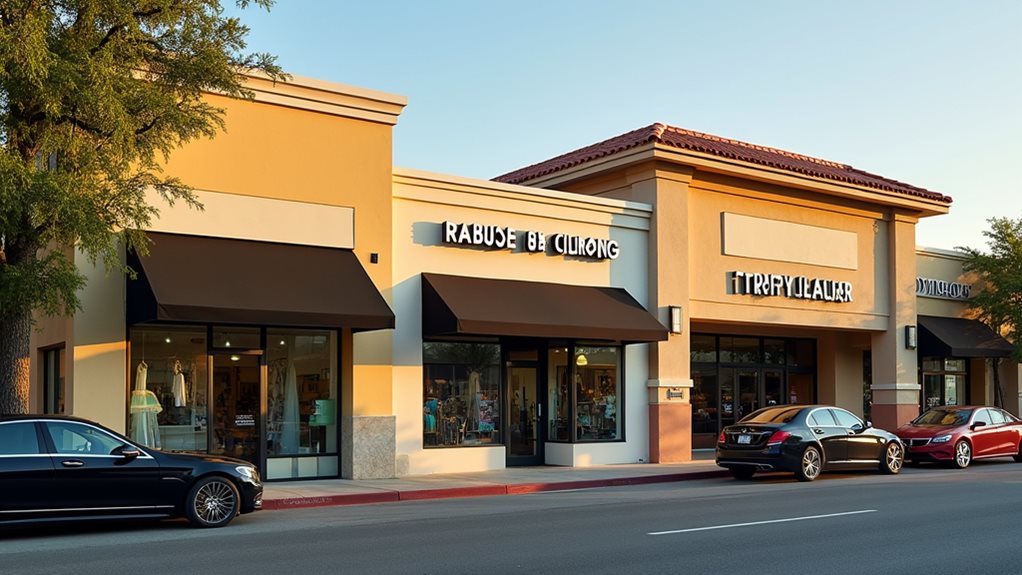
Your dry cleaning business’s location will dramatically shape your monthly earnings, and I’ve seen firsthand how a move from Main Street to downtown can triple your revenue overnight.
If you’re considering a small town setup, you’ll typically pull in around $2,000 monthly, which honestly feels like pennies when you’re working those long hours.
But urban locations consistently generate closer to $10,000 per month. The difference isn’t just about population density – it’s about lifestyle, disposable income, and the simple fact that city folks tend to drop off their clothes more frequently than rural customers who might own one good suit 😊.
This revenue disparity reflects broader industry trends, where increasing urbanization continues to drive higher demand for professional garment care services in metropolitan areas.
Small Town Revenue
Although small town dry cleaning operations might seem less lucrative at first glance, they often surprise entrepreneurs with their steady, predictable revenue streams that can sustain a comfortable living.
Your dry cleaning business in small towns typically generates average monthly revenues around $2,000, which translates to roughly $24,000 annually – not flashy numbers, but surprisingly reliable ones.
Customer expenditure per visit ranges from $20 to $50, with folks visiting one to four times monthly, creating that beautiful predictability we entrepreneurs crave.
Here’s where it gets interesting: your operating costs stay remarkably low compared to urban markets, allowing profit margins between 10% to 25%.
You’ll need to hit your breakeven point by servicing about 2,000 pieces monthly, but honestly, that’s quite achievable with consistent local relationships! 😊
While small town revenues appear modest, they contrast sharply with larger operations where startup costs can reach $200,000 to $300,000 before opening your doors.
Urban Location Earnings
The bustling energy of urban markets transforms dry cleaning from a modest small-town venture into a potentially lucrative enterprise, where your monthly revenues can soar to an impressive $10,000 on average – that’s more than quadruple what you’d see in smaller communities!
Urban location earnings really shine when you’re positioned in high-end metropolitan areas, where premium services can push those monthly revenues up to $30,000 (yes, you read that right! 💰).
Your annual revenue typically ranges from $120,000 to $360,000, thanks to diverse clientele including busy professionals and local businesses.
The magic happens because your average spending per customer jumps to $20-$50 per visit, dramatically boosting profitability compared to rural counterparts.
The most successful urban dry cleaners maximize their earning potential by offering additional services like alterations, shoe repair, and convenient pickup and delivery options that cater to their busy metropolitan customers.
Operating Expenses and Cost Breakdown Analysis

When you’re diving into the dry cleaning business, understanding your operating expenses becomes the difference between floating comfortably or sinking fast in this competitive industry.
Your initial investment costs will hit around $80,000 to $150,000 for cleaning equipment and chemicals, which honestly makes my wallet weep just thinking about it 😅.
That $80,000-$150,000 upfront cost for dry cleaning equipment will definitely have you questioning your life choices 💸
Managing those fixed monthly expenses of roughly $10,000 means you’ll need to process about 2,000 pieces just to break even.
Here’s what’ll eat into your monthly income:
- Chemical solvents and specialized cleaning supplies
- Equipment maintenance and utility bills
- Staff wages and rental costs
- Marketing expenses and insurance premiums
Smart cost management strategies, like negotiating supplier contracts, directly impact your profitability since gross margins typically hover between 30-50%.
Beyond equipment and supplies, you’ll need substantial working capital to sustain operations during your first few months while establishing a reliable customer base.
Profit Margins and Net Earnings Potential

Since your monthly expenses are already mapped out, you’re probably wondering what kind of profit you can actually pocket from this venture, and honestly, the numbers might surprise you in both directions.
Traditional dry cleaning operations typically see profit margins hovering between 5% to 8%, which means your net earnings from average yearly gross revenues of $150,000 to $300,000 could range from modest to decent.
However, here’s where it gets interesting – eco-friendly practices can bump those margins to around 10%, and subscription-based models can boost monthly revenue by 15% to 25%.
Your operational efficiency and customer demographics will ultimately determine whether you’re scraping by or living comfortably, but don’t expect overnight riches 😅.
Successful businesses often supplement their core cleaning services with specialty garment care, alterations, and leather cleaning to significantly boost their overall profitability.
Breakeven Point and Financial Performance Metrics
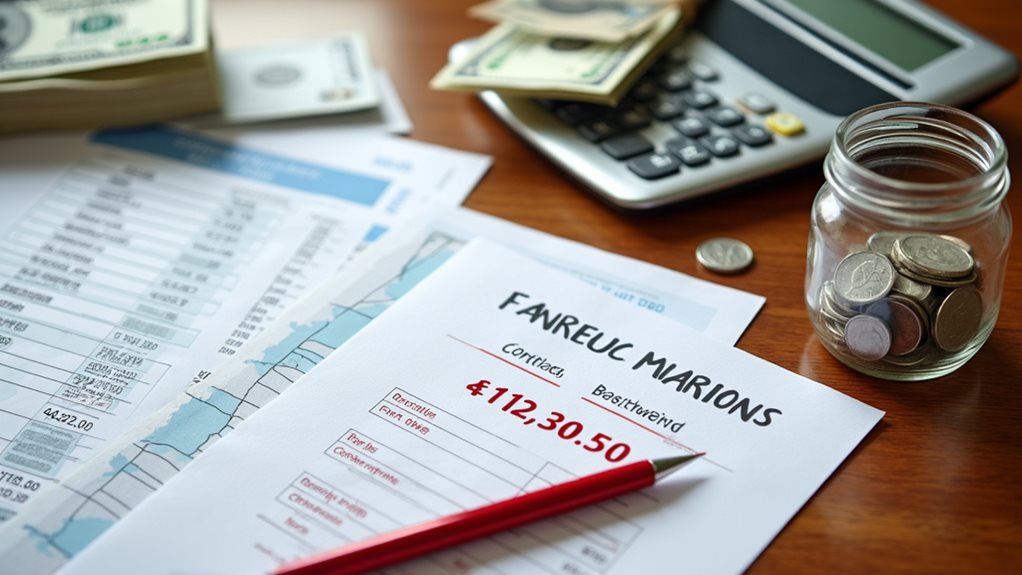
Understanding those profit margins is helpful, but you’ll need concrete benchmarks to measure whether your business is actually hitting its financial targets, and that’s where breakeven analysis becomes your best friend.
In the dry cleaning industry, your breakeven point typically requires servicing around 2,000 pieces monthly to cover those pesky $10,000 fixed expenses that keep showing up regardless of your gross revenue.
Here’s what separates thriving operations from struggling ones:
- Volume consistency – maintaining steady customer flow through effective management and superior service quality
- Cost control – tracking every expense from utilities to cleaning supplies with ruthless precision
- Revenue optimization – maximizing monthly earnings through strategic pricing and premium services
- Financial performance monitoring – reviewing metrics weekly, not quarterly 📊
Smart owners who master these fundamentals often see their monthly earnings climb steadily toward that coveted $15,000+ range.
Factors That Impact Dry Cleaning Business Profitability
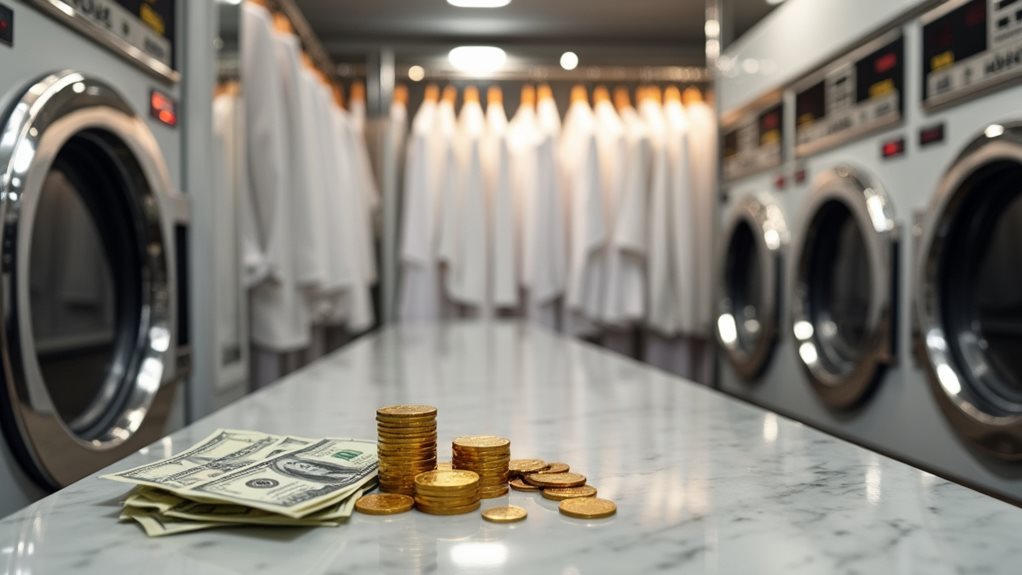
Although hitting your breakeven numbers feels like a major victory, several key factors will determine whether your dry cleaning business becomes a consistent money-maker or struggles to stay afloat.
Reaching breakeven is just the beginning—transforming your dry cleaning business into a profitable venture requires mastering several critical operational factors.
Honestly, I’ve seen too many owners focus solely on volume while ignoring the operational decisions that truly drive profitability for a dry cleaning business. Your operational efficiency becomes your secret weapon here, especially when you adopt eco-friendly practices that can slash costs by 20% while boosting margins from 8% to over 10%.
Smart pricing strategy helps you steer through seasonal demand fluctuations, while customer acquisition and retention through app-based services creates loyalty that translates directly into consistent revenue.
Delivering high-quality service consistently is what separates thriving businesses from those barely surviving.
Owner Salary Ranges and Income Optimization Strategies

When I first started consulting with dry cleaning business owners, I was honestly shocked to discover how many talented entrepreneurs were barely paying themselves minimum wage while working 60-hour weeks.
It broke my heart because most of them didn’t realize that owner salaries between $60,000 and $90,000 annually weren’t just pipe dreams but achievable targets with the right income optimization strategies.
Here’s what transforms struggling owners into well-compensated business leaders:
- Implement subscription-based models to boost monthly revenues by 15-25% while creating predictable cash flow
- Adopt eco-friendly practices that can enhance profit margins from 5-8% to around 10%
- Utilize data-driven scheduling and marketing to reduce operational costs by up to 20%
- Develop tiered pricing strategies that adjust rates based on service complexity and demand
Operational efficiency isn’t just buzzword fluff—it’s your pathway to financial freedom.
